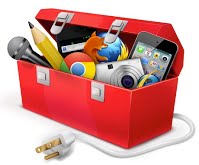
Students (and teachers) who use technology to access information while using digital tools to create and communicate develop a personalized set of resources for learning – a “go-to” technology and information toolbox – a Personal Learning System (PLS). They work to maximize their “learning flow” (think about workflow for those in the work world).
Finding and using active, organized, and collaborative tools are critical to managing individual and group learning projects. Self-directed students use devices, apps, web tools, and information sources, putting themselves in charge of their learning. Students also need to be project managers who engage their PLS as they plan for long-term assignments while often working as team members.
Active and independent students in command on the bridge of their learning ship are ready for blended to full-out virtual learning opportunities. Engaging with the school Learning Management System (LMS) and other platforms for collaboration and creation furthers our students to trek into expanded learning beyond the school and regular hours of learning.
A Personal Learning System (PLS) can include supportive tools in a variety of categories. The following are a handful of options among many.
- Creation- Learners are shifting away from generative software that ties their creativity to a device. While there are many cloud-sharing services, it is making more and more sense to use web-based creation tools for 24/7 access and collaboration with partners and teachers. The list is long for these style creation tools, with several noted bloggers constantly writing about new options for web-based creation tools and tools that support all the PLS categories listed here. Here are a few bloggers to follow. Kathy Schrock | Larry Ferlazzo | Richard Byrne. There are several curated lists of tools to keep an eye on. 101 Web Tools | 21st Century Tools | Top 100 Tools for Learning
- Communication– We use e-mail, phones, and social networks to connect with others. Examples: Gmail, Hangouts, texting, phone calls, Skype
- Collaboration– Communicating to share ideas, work on projects and innovate draws upon and develops skills for 21st-century learning and the workplace. Technology facilitates the process of developing, organizing, and sharing those ideas. Examples: Google Apps, Moodle (LMS), MindMeister
- Curation of Information– Personal Learning Systems are more effective with a place to store, organize, and share the digital information we consume and create. Examples: Google Drive and Keep, Scoop. it! along with a Scoop.it! collection of PLS tools, Dropbox, Diigo, Pocket,
- Documentation of Information– We need places and modalities (ex., voice-to-text) to record and responsibly cite the ideas we gather from others and make our thinking visible. Examples: Noodle Tools, Evernote, Notability, MindMeister, Siri, Google Now, PaperPort Notes, Google Docs for typing and voice recording to text, Audioboo
- Project Planning– Planning for projects that involve creating a learning product engages students in using many tools in their learning system. Watching students use their Information & Communication Literacies (ICL) and their PLS tools can be a fascinating aspect of teaching. Scaffolding does need to be in place to support students, whether working individually or in teams, as they manage their time and resources to be efficient and productive. What can support this process is to provide students with a project planning template with guiding questions and supportive ideas to have them create their plans. Regarding ICL, the plan could be called the ICL Project Plan. This blog post offers a few ideas about guiding students to create an ICL Project Plan.
- Reference and General Information Gathering– Remember when we had a dictionary, thesaurus, calculator, and an encyclopedia within easy reach of our workspace? Today we have online versions of each and various apps on our devices. Examples: English dictionary/thesaurus apps, Spanish dictionary apps, French dictionary apps, language translators, Britannica, iTunes for Podcasts, Chrome Browser with Extensions, and one’s school library Web site with its list of databases. Adaptive technologies like the Rewordify Web site help students simplify text above their reading level to make it more understandable. The growing Open Educational Resources (OER) is another area for students to connect to for information.
- Task and Time Management– The paper planner and calendar do not provide all the services offered by a web-based event and task management calendar. We can now easily access our time management systems across our computing platforms and integrate appointments and tasks into our e-mail. We can often share our appointments and timelines with team members to support collaboration. Examples: Google Calendar, Todoist, Wunderlist
- Tutorials and Courses– Developing lifelong learners who know how to learn independently is one of our primary goals. Knowing where to go to not only gather information but also learn specific skills via online tutorials is so essential. Examples: iTalki and Duolingo for languages, Vimeo Education and Khan Academy for across-the-board tutorials, Knewton for individualized tutorials, and iTunes University.
This post originates from the Personal Learning System page of the Web Resources for Learning Web site. Also, check out the Edtech Co-Op podcast, where a couple of years ago, Mark and I talked about the announcement from Apple for iBooks and our thoughts on how students could personalize them. The show offers our initial thinking about personal learning systems.